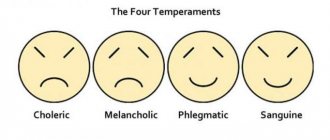In psychology, the halo effect (halo effect) is often considered negative. Why? Because this effect can take a form that is often called the “devil effect.” Here's a simple example: a court and two suspects. A person with a cognitive distortion (halo effect) will blame the suspect who seems less attractive to him. We are talking about a situation where the general idea of something affects the perception of particular components. In the example shown, the overall evaluation of a person is tied to his appearance or behavior: if one suspect behaves well and looks the part, he is not likely to be negatively evaluated.
What does the “halo effect” mean, what signs are significant in its context, how appearance and other characteristics of a person are related to cognitive distortion - we will talk about this and much more today.
Halo effect - what is it?
In general, the halo effect is considered by psychologists as a cognitive distortion of a person (in the form of systematic deviations in behavior, perception, thinking), caused by subjective beliefs or prejudices, attitudes. A person with such a cognitive distortion is often influenced by stereotypes, often fictitious ones. An example of the halo effect is the belief that a person with an attractive appearance is necessarily smart, that is, has an “attractive” mind.
Psychologist Edward Thorndike became the first scientist to prove the existence of the halo effect in some people. He conducted a large-scale experiment and obtained indisputable evidence.
The phenomenon of the halo effect itself is often tied to first impressions. A person with the cognitive distortion in question, when communicating with other people, relies precisely on a stereotype formed independently in his mind, based on the first impression. It can be positive or negative, according to which communication will be structured: either in a positive way or in a negative way.
Theory and practice of researchers suggest that the halo effect is often negative. Recall the example shown with two suspects. Another example is the work of Phil Rosenzweig, “The Halo Effect and Other Eight Illusions That Mislead Managers.” The author was able to show how the cognitive distortion in question that some managers face negatively affects business.
According to various psychologists, 8 out of 10 people personally experience the halo effect. That is, 8 out of 10 people can be considered biased.
Have you noticed the halo effect?
Yes, it seems to me that not only for myself. Many people are like that. At least in my surroundings.
0%
Yes, but, oddly enough, it doesn’t always “work”. Why this happens, I don’t know.
50%
No, I think I'm one of those two out of ten people who are not biased.
50%
Voted: 2
Examples
The negative halo effect (it would be more correct to say the negative effect of the halo effect) is manifested in the fact that an erroneous first impression can lead to subsequent erroneous judgments regarding the object, subject or subject of evaluation. This is an extremely negative point, because in practice, in the worst case, it results in a lot of problems.
Let's give 7 specific examples to better understand the essence of the effect. Here they are:
- Attitude towards creative personalities and celebrities. It is often filled with conditional “indulgences”: if a creative person behaves inappropriately, he is often justified (“All geniuses are a little peek-a-boo”, “It’s clear, he’s not of this world”). If a commoner exhibits similar acts of behavior, he is more likely to be reprimanded.
- An attitude towards a manager at an enterprise who initially showed his strengths, but subsequently made a lot of mistakes. The latter will be forgiven, while higher managers will always give such a manager chances. If another, for example, a specialist, made a lot of mistakes at the very beginning of his journey, his subsequent achievements will be assessed by higher managers not quite adequately to reality, their significance will be underestimated.
- Consumer trust in brands. Example - “Coca-Cola” and “Drinks from Chernogolovka”. Who do consumers trust more, who are they more willing to choose? 8 out of 10 would prefer Coca-Cola.
- Trust familiar manufacturers. An example is owners of Sony and IPhone smartphones. The former will give preference to Sony household appliances, while the latter will be more willing to buy some goods produced by Apple.
- A positive impression when meeting a person with whom you will communicate in the future. This impression will negatively affect the adequacy of reality in assessing negative qualities; it will “say” that the person you previously liked cannot be bad.
- Perceptions of attractive interlocutors. This is the most obvious example. We often try to treat them better than those who are not attractive to us.
- The employer's prejudice is that people who are more attractive and neat in appearance will also be neat in business. This is not always the case. Even the most attractive and decent, as it seems at first, employee can be a negligent and irresponsible specialist.
The halo effect is often associated with lookism, that is, discrimination based on appearance. The concept is used to refer to stereotypes and prejudices according to which physically attractive people are much better than unattractive people in every way.
Have you experienced the halo effect happening to you?
Yes, I encounter it all the time. It seems that all people, as they say, are greeted by their clothes.
100%
Yes but rarely. Or I don’t pay attention to other people’s opinions.
0%
No, no one has ever treated me with prejudice, from the position of “must comply.”
0%
Voted: 2
Application in advertising
By influencing people's impressions, marketers increase sales of various products.
As a rule, the company initially tries to gain the trust of the consumer. After this, buyers purchase the product, first of all paying attention to the brand. And the degree of influence on decision making by price and quality become secondary. When a new product appears in a brand's line, it generates consumer interest due to the initial positive impression of the brand's products. Thus, the cost of a product from a well-known brand will be noticeably higher than that of a little-known product. Sometimes the price difference can be hundreds of percent, despite similar consumer qualities.
The halo effect is widely used when advertising products by famous people. In the case of famous actors, we can say that there is even a double halo effect at work here. Actors, as a rule, transfer the positive qualities of the characters they played. And the actors are already transferring a positive impression on the advertised products.
Beautiful packaging can enhance the perception of product quality. In the same way, the appearance of buyers in advertising, their expensive clothes, can create associations with the quality of the advertised product.
Causes of the halo effect
Thinking in stereotypes, patterns, labels - all this is about people facing the cognitive distortion in question. It has already been noted that approximately 80% of people are prime examples of how the halo effect works. Why is this happening? To understand, you need to understand the reasons.
The following shows and describes 4 common causes of the halo effect:
- Lack of time . In the face of time pressure, the halo effect occurs in people faced with the need to make many decisions with high frequency. Especially often, distortion develops in people who act according to patterns, lose the ability to analyze, and are guided only by some basic criteria, for example, people’s appearance. The originality in it “breaks” the patterns of such people and causes negative feelings.
- Information overload . Not always and not everyone can adequately evaluate people, events, and phenomena in conditions of information noise. Here everything is the same as in the first case: the first acquaintance, for example, with any person in terms of value judgments will be based on a set of basic criteria (appearance, cleanliness of shoes, ability to conduct a dialogue, etc.).
- Susceptibility to the influence of stereotypes . Different patterns, which is understandable, greatly hinder us. They do not allow us to objectively evaluate people, phenomena, and objects. An example is a hooligan for whom no one is likely to predict a bright future. Another example is a beauty who must find a prince and live a happy life with him. In fact, a bully can improve and become one of the people, and a beauty can connect her life with a person who is far from conforming to stereotypical, cliched ideas.
- Statuses . Imagine that you are meeting some outstanding businessman. You will almost certainly get the idea of him as a person with high moral and strong-willed qualities. In fact, a business may turn out to be the result of illegal activities, “infusions” from parents, or something else that has nothing to do with a person’s qualities.
The halo effect is often described as a person's desire to label others. Some conservatism and even narrow-mindedness, stereotyping in a number of important issues is what forces a person to draw incorrect conclusions and make errors in judgment.
Do you think that a person’s stereotyping in assessing other people only gets in the way?
Certainly! We are all individuals. And we are all different. What stereotypes could there be here?
50%
Yes, but there are, in my opinion, universal standards. For example, demeanor. All people should behave well.
0%
No, if there were no stereotypes, the world would be in chaos and chaos.
50%
Voted: 2
Bottom line
A person’s perception of the outside world is initially based on stereotypes that are determined during life.
Acting according to a pattern, an individual feels comfortable because he is within a society that lives according to the same principles. The halo effect helps people not only adapt in society, but also process a lot of information in a short time. But should you trust him with everything? Do you agree with this? Please express your opinion in the comments to the article.
Dagirova Lidiya · May 15, 2019
How does the halo effect affect people?
Most often negative. Yes, sometimes, for example, meeting a new person who inspires trust does not lead to disappointment and erroneous judgments, but in fact, the halo effect prevents you from objectively assessing the qualities of people.
The halo effect is almost identical to the saying “meeted by clothes, seen off by mind.” And often you have to pay for such “meetings”. Phil Rosenzweig’s work, “The Halo Effect and Other Eight Illusions That Mislead Managers,” already cited as an example, allows us to understand the negative consequences of the halo effect. Yes, this is a large-scale example - this is a business where any mistake can cost millions, but it is the most obvious.
Imagine the situation: the management team of a large enterprise includes people with prejudices. All their decisions will be based on stereotypes, on some templates. They won't be able to think outside the box. Phil Rosenzweig showed that sometimes the halo effect in management can cost even brands not just millions of dollars, but also their reputation. And she is priceless.
In a business context, the influence of the halo effect on subordinates can also be considered negative. Often managers who choose outwardly attractive people, for example, as their assistants, voluntarily or unwittingly do not notice their lack of useful qualities. The result is incorrect management, unfair treatment of subordinates, decreased labor discipline, discord in the team and more.
The example shown clearly reflects the negative aspects of the halo effect . This:
- lack of rationality in assessing people and events;
- a person’s inability to reason independently, that is, without reference to one’s own stereotypes and patterns;
- the likelihood of discrimination on one or another basis.
The aspects in the list are only a small part of what can be the consequences of the halo effect. In any form, it is often negative, but should not be considered positive. Sobriety and balance in decision-making, judgment, and conclusions are important. Especially in relation to other people. We will not be able to live in absolute peace as long as we judge each other by some personal, far-fetched, stereotypical criteria.
There is an opinion that the danger of the halo effect comes down to the fact that it often manifests itself not only at the everyday or other local levels, but also at the level, for example, of politics. Heads of state who consider some “neighbors” attractive and others not, can impose trade and other sanctions against the latter and initiate military conflicts with them. Ordinary people will suffer. Anyway. For this reason, modern researchers are increasingly turning to this problem and calling for fighting with all available methods against the cognitive distortion in question.
Is the halo effect a real danger to people?
Yes, I completely agree (agree) with what you write.
50%
No, it seems to me that there should be stereotyping. More often than not, stereotypes are based on centuries of experience; they are necessary. Even if they manifest themselves in a halo effect.
50%
Can not say. Either I don’t realize the scale of the problem, or I just don’t quite understand why the effect is so bad.
0%
Voted: 2
Conditions of occurrence
Most often, the halo effect occurs under the following conditions:
- Lack of time. It is not always possible to get to know someone closely, to find out how he behaves in various situations, and so on. Why does a lack of information distort the reality of our perception? Consequently, we have to rely on the minimum that we can grasp.
- Lack of interest. Either the person himself did not arouse the desire to get to know him better, or due to various circumstances a state arose when fixation of attention was concentrated on one’s own experiences and thoughts. The result is a chaotic, vague idea of the interlocutor.
- Information overload. Every day we come into contact with a lot of people. Therefore, sometimes there simply are not enough resources to think about each of them for an objective assessment.
- Stereotypes. There are many stereotypes in society that we react to and use at times when there is no desire to personally explore and test reality.
- Feature of appearance or character. She can take all the attention to herself, making other characteristics unimportant. For example, when talking with and admiring the winner of a beauty contest, it is quite difficult to maintain clarity of mind and notice the real her, with flaws and imperfections.
Experiments and research
There are many interesting experiments and studies on the halo effect. We will show some with reference to different areas of activity and situations.
Medicine
A team of psychologists from the University of Saint Andrews (Scotland) conducted a study which found that 7 out of 10 doctors participating in it are biased towards beautiful patients. Psychologists have been able to prove that doctors often consider beautiful people healthier than ugly people.
In fact, such bias causes doctors to omit important questions or not use necessary diagnostic tools. The consequence may be an undetected disease, for example, in a latent form.
Business
Now we are not talking about an experiment or a study. However, this is a historical and important example in the context of the problem under consideration. We are talking about Cisco (an American multinational company specializing in the production and sales of network equipment). Analysts and stock market professionals noted when the company's stock price was high that it knew how to work with consumers and stick to its own strategies. During one major crisis faced by Cisco, the opinions of analysts and professionals immediately changed.
Personal relationships
There is a study conducted by specialists from the Massachusetts Institute of Technology, which confirms that a few fractions of a second are enough for a person to analyze the appearance of a stranger and conclude whether communication with him would be pleasant or not.
It is worth noting the study conducted by Marcel van der Linden and his colleagues. As a result of the experiment, people’s bias towards others, determined by the “appearance” criterion, was revealed. The essence of the experiment was as follows: one of two groups of subjects was asked to look at a photograph of a girl with tied hair, the second was asked to look at the same thing, but with loose hair. In both photographs the girl was alone. Members of the first group (95%) noted that the girl is most likely shy and closed. Members of the second group (87%) thought that she was quite open and almost certainly kind.
Have you experienced bias at work, school, or anywhere else?
Yes. At work. And it’s not very pleasant when management thinks in their own, often subjective, categories.
50%
Yes, while studying. Teacher bias is a big evil.
0%
Yes, in communication with the opposite sex. And it’s terrible when you are expected to meet some incomprehensible standards, and in case of non-compliance they are considered not so (like that).
50%
No, I'm lucky.
0%
Voted: 2
Recommendations
One can accuse the commanders in Thorndike's experiment of being biased and, in general, anyone who forms an opinion about another person without getting to know him very well. But if you think about it, each of us constantly falls into this trap. For example, a tall, large man with pumped up muscles reproduces the impression of a hardy and strong person. Capable of surely protecting anyone weaker than him. And also withstand a lot of troubles and problems without breaking spirit.
This is exactly how women can sometimes think when choosing a partner. And stubbornly fail to notice that he is actually trying at every opportunity to avoid responsibility, work, and constantly doubts himself. Then experience disappointment that he turned out to be not as beautiful as he looked at first. And this disappointment threatens to lead to distrust of men in general, or even worse - to depression.
The halo effect can bring a lot of problems, both to the one who is incorrectly assessed and to the one who evaluates. The simplest example: without getting to know a person well, you can push him away and lose a true friend or companion. Trusting someone who at first glance seemed interesting and safe, but in reality being betrayed and deceived.
Recommendations to help avoid this phenomenon:
Integrity
Expand the boundaries of perception, that is, do not form an opinion about a person based on only a few characteristics of his personality or actions. One-sided judgments lead us into a trap. For example, your colleague can be both evil and kind. Depending on the situation, his mood, etc., he will behave differently. Each of us is multifaceted, it’s just that some character traits are more pronounced. But this does not mean that those that are polar to them, that is, completely opposite, are absent. In other words, even the nicest person in the world in some situation shows himself to be cruel and callous.
In psychology there is such a thing as a perverted narcissist. This is a person who manipulates others for the purpose of destruction. So, at first glance, she may seem quite charming and charismatic, otherwise how else to lure the victim? The first opinion about them is usually positive; it seems that we managed to meet the most interesting person in the world, who guesses desires and understands as no one else has ever understood. And then, when a partner becomes attached to him, becomes dependent, he reveals his true face. And the torment and mental torture begin.
Therefore, refrain from making superficial judgments. Look closely and tirelessly get to know the other person. We are all constantly changing. And judging even your partner one-sidedly, thinking that you know him like no one else, is a big mistake.
Reality testing
The essence of this recommendation is to constantly compare any information with reality. For example, many students use the halo effect to their advantage. Entering the first year, they study diligently and behave quietly in classes. Do you know why? Because there is an opinion that how you prove yourself initially is how teachers will treat you throughout the entire time until you receive your diploma.
And indeed, those who later start skipping classes and don’t turn in work on time are given concessions, “turning a blind eye” to many nuances. The teacher knows the student’s capabilities, knows what he was capable of. And to the last he can strive to “pull” it out. Losing objectivity.
FAQ
Below are answers to common questions related to the topic of the halo effect.
What are the psychological effects?
In general, psychological effects include various stable, easily detectable patterns that reflect the interpersonal characteristics of people’s relationships in society. These effects reveal the features of communication processes. Here are examples with explanations: the placebo effect (belief in the healing properties of an object that does not have them); cold reading (used by psychics to instill in people the idea that they are “in the clear”); audience effect (a person’s activities under observation and outside observation are not the same); sequence effect (people’s reaction to one event changes, the sequence of occurrence of which differs from the conditional pattern).
What is the leniency effect?
This effect manifests itself in the fact that a person shows excessive attention to the positive aspects of another and elevates them. At the same time, shortcomings, even obvious and clearly negatively colored ones, are almost not noted by a person with such a cognitive distortion; he does not attach significance to them.
What influences the creation of a first impression?
Traditionally, it is believed that the first impression depends solely on appearance. This happens when people meet. If they liked each other externally, the first impression will be positive; if not, it will become negative. Further, as many psychologists note, both will evaluate communication abilities: verbal, non-verbal gestures. There is an opinion that the first impression can be not only conscious, but also unconscious. In the first case, a specific person in the assessment process applies some criteria, often personal (halo effect), in the second, everything happens by itself, that is, the person does not intentionally “give grades”.
What might the first impression be?
In the answer to the previous question, it was shown that based on the criterion of “awareness,” we can say that the first impression can be either conscious or unconscious. It is also common to talk about positive and negative first impressions. In the first case, the value judgments of one person in relation to another, which is understandable, will be exceptionally good. In the second, the speech will concern the situation of rejection, rejection, when one person seems to another ugly, unkempt, unable to communicate, and so on.
How to create a good impression of yourself?
Here are some simple tips. Need to:
- smile sincerely. “Forcing” a smile means making a person think about insincerity;
- follow your gaze. It is recommended to “hold” it on a person for approximately 35-40 seconds per minute, the rest of the time it should be directed at other objects. Yes, it’s difficult to track, but you need to strive for it: eyes constantly running over your clothes, face, figure, or absolute visual inattention - this is what will make a person think of you as an “evaluator” or as an uninterested interlocutor;
- keep your posture. Everything is simpler here: correct posture in itself is considered good manners. This stereotype can always be used to your advantage;
- stop worrying. Anxiety makes us withdraw into ourselves. For this reason, it needs to be fought. Especially when you want to make a good impression;
- think through communication and communication situations in advance. This is like a rehearsal before a concert: without it it is difficult to navigate the stage and behave correctly. The same is true when meeting people. You should think through all the details in advance, even small ones, so that during a real acquaintance you feel like you feel like a fish in water.
History of origin
Initially, back in the 1920s, Edward Thorndike spoke about this phenomenon. He conducted an interesting experiment by asking two commanders to characterize and evaluate their platoon. It was necessary to start with physical data, such as physique, timbre of voice, endurance and activity. Then move on to intellectual capabilities. And also indicate how capable each of them is of finding a common language and collaborating with others. Lead, support, take responsibility for decisions and mistakes made.
The results confirmed Thorndike's guesses about how our perception is distorted in such moments. It turned out that the soldiers who received high marks for physical characteristics also had quite high other marks. The one who looked weak outwardly did not stand out in the eyes of the commander with other abilities. In terms of other characteristics, it also did not reach the norm.
Afterwards, already in the 1970s, Robert Cialdini stated that subconsciously we like more attractive people, so much so that we endow them with non-existent positive qualities. But we reject less sympathetic personalities completely, attributing to them and noticing mostly negative things. Those whom nature has deprived outwardly too clearly can generally be considered fiends of hell.
Examples
Previously, it was believed that the halo effect only occurs in interpersonal relationships. This is an incorrect statement.
In addition to communication, a person, a child of society, must meet a number of requirements for so-called adaptation, which consists in organizing the standard process of life.
Examples of the halo effect in psychology:
- a person with a pleasant appearance is perceived as more intelligent and successful; even with the same professional indicators, he receives more benefits, and often his position;
- people with external defects cause distrust and often rejection, regardless of personal achievements; they must always prove their abilities and kindness to the world around them;
- when purchasing household appliances, the buyer will initially trust a manufacturer that is already known or has received positive feedback from friends;
- a person will prefer to buy a laptop with a bright design, because initially he will consider it more functional;
- Having once purchased a tasty product from a certain company, an effect of trust arises, which then constantly manifests itself in the future;
- women are bad at driving cars, so they are not attentive drivers, and yet many representatives of the fairer sex are more obliging drivers than men;
- the label of a winner does not guarantee the presence of hard work, but it helps in conquering the pinnacle of success for some time;
- if Vova gets straight A's, he can't be a bully.
The halo effect is a powerful psychological weapon
Research has also shown that, despite a person’s external attractiveness, people still tend to assume that he may turn out to be vain, dishonest, cruel, etc. For example, seeing beautiful models in advertising who supposedly get younger “before our eyes” from some then people begin to mistrust.
But they can be convinced that there is a criminal in front of them. If you show a person with a repulsive appearance. Or, conversely, a maniac can avoid punishment for a long time if he is handsome and kind to others. In this case, people will transfer their sympathy for him to his personality as a whole. And no one will even think that a killer is hiding behind the outer shell.
Basic diagram of the halo effect
The halo effect pattern is when a perception is applied that is triggered by inequality in intellectual, social and other areas. People have a tendency to overestimate some qualities of a person superior to them, even in one significant parameter. If a weak and sickly person meets a strong and healthy person, he perceives him as smart, handsome, kind, etc. Moreover, there is a possibility that in reality the first overestimates the second, and quite strongly. The qualities of this person often turn out to be completely different from what they really are.










